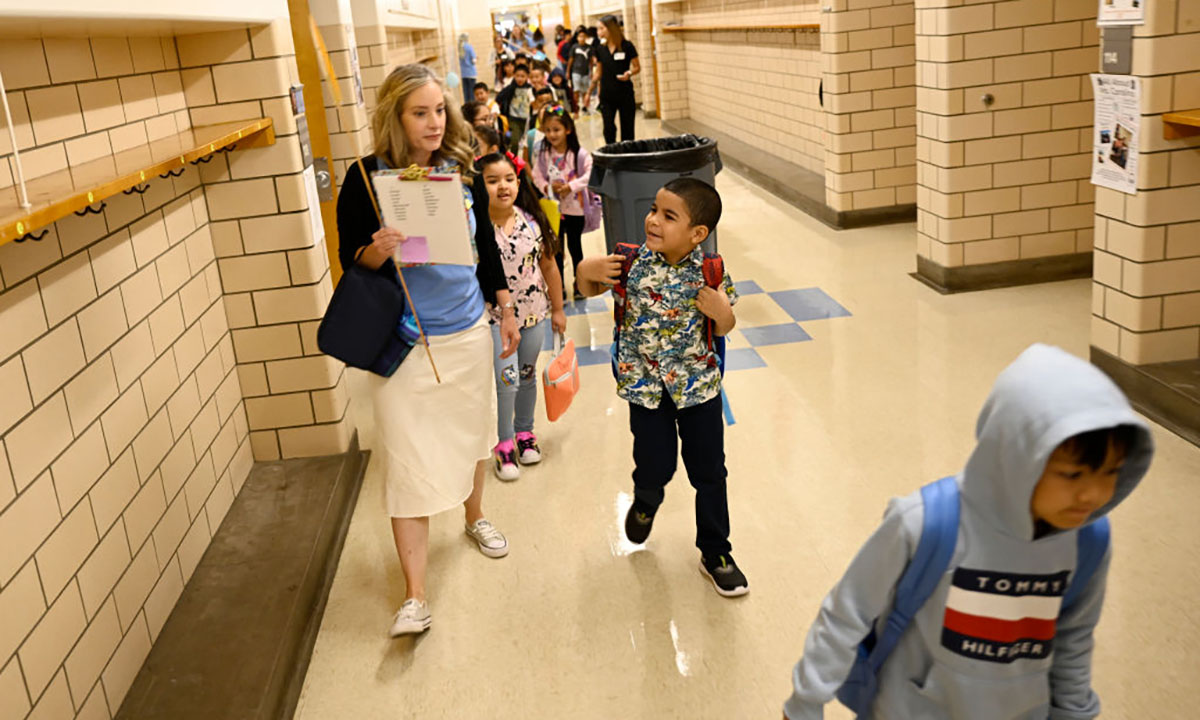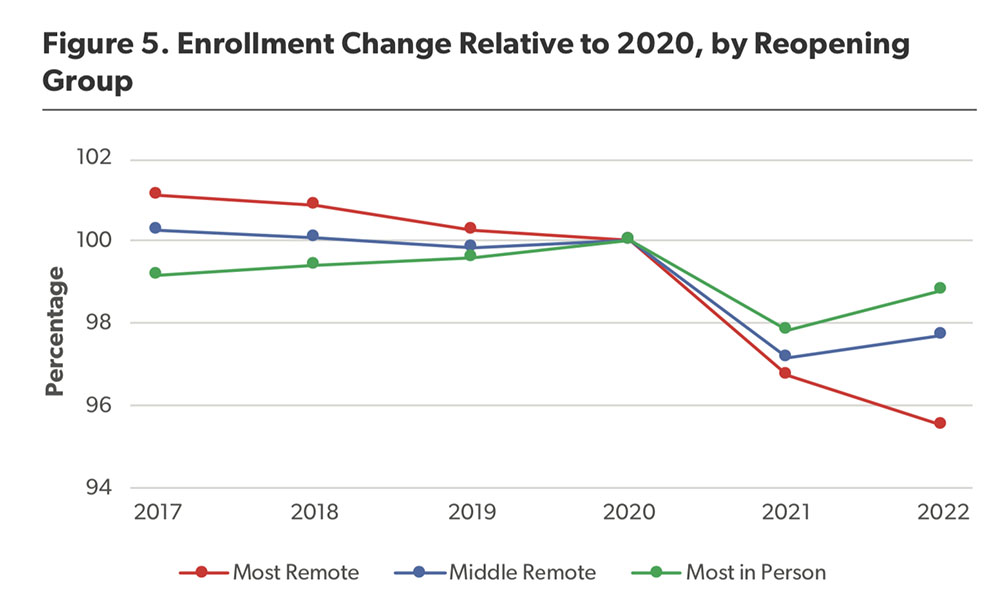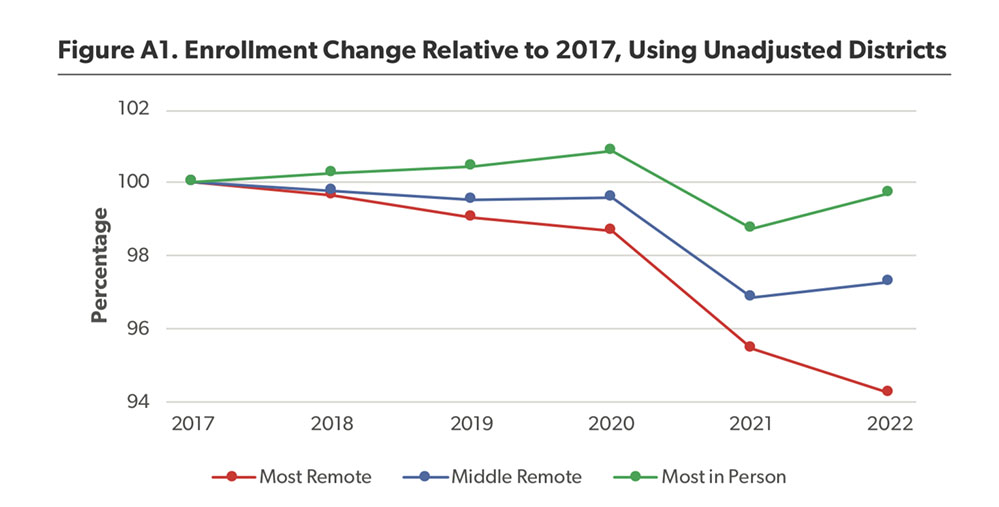Pandemic-Related School Closures Fueled Enrollment Exodus, Report Finds
But the return of many pre-K families to districts is softening the impact of further declines

Get stories like this delivered straight to your inbox. Sign up for The 74 Newsletter
Districts where students spent the most time in remote learning during the 2020-21 school year lost at least half a million more students than they would have if they’d stayed open, a new report shows.
And those that offered mostly in-person learning during the first full school year of the pandemic not only lost fewer students but were more likely to recover enrollment the following year, according to the paper, released Monday from the American Enterprise Institute.
The analysis shows that enrollment loss was not just “pandemic-related; it was pandemic-response related,” said Nat Malkus, a senior fellow and the deputy director of education policy at the conservative think tank. The same, he said, applies to the decline in achievement chronicled in recent National Assessment of Educational Progress results.
“The idea that this is behind us is just absolutely wishful thinking. The consequences are very real,” he said. “Some say you’re going to wear your audience out by saying ‘learning loss, learning loss.’ But if we had learning gains of the same size, how many headlines would we be looking at?”

The study confirms a pattern that researchers at Stanford University identified in 2021 and takes it a year further to show that families didn’t come flooding back to districts once they reopened. Now, almost three years after the pandemic began, more districts face the possibility of school closures because of that enrollment loss. And some have used federal relief funds to make up shortfalls in their budgets resulting from lost students. That means the so-called “fiscal cliff” will be even tougher when funds dry up in two years, Malkus said.
Preliminary enrollment figures for this school year are just beginning to trickle in from the states, and so far the outlook is mixed, according to Burbio, a data services company. Hawaii enrollment declined for a fourth straight year. After a rebound last year, enrollment in New Hampshire is down 1%. Delaware and Arkansas have seen small increases of less than 1% compared to last year, while enrollment is up 1.3% in North Dakota.
It’s important to note, Malkus said, that urban districts that were closed the longest and had the most enrollment loss were also steadily losing students before COVID. The pandemic just accelerated that loss.
Those who moved their children to new schools during the pandemic might also be reluctant to make another change even if their lives returned to relative normalcy, Thomas Dee, a Stanford University economist who led last year’s research, wrote in a recent commentary.
That seems to be the case for those who enrolled in charter schools. Recent data from the National Alliance for Public Charter Schools showed that the large gains during the 2020-21 school year have “held steady.”

Growth in pre-K
While districts lost students in middle and high school, leaders’ decisions to stay remote in 2020-21 placed “larger burdens” on families with children in the early grades and drove them to search for alternative schools that offered in-person learning, Malkus wrote in his report.
Young children, however, are now contributing to some enrollment growth. Data compiled by Burbio, shows that pre-K students boosted enrollment last year in multiple districts, from Trenton, New Jersey, to Provo, Utah. In others, pre-K enrollment softened the blow of declines. For example, in Rochester, New York, enrollment would have been down 4.4% last year without pre-K. Instead, it decreased 2.5%.
Pre-K also partially accounts for an enrollment increase in the District of Columbia Public Schools this year, even though experts expected declines.
The impact of early-childhood programs on K-12 enrollment is particularly evident in California, now in the first year of a statewide expansion of transitional kindergarten, a program for 4-year-olds offered in elementary schools.
A recent report from the state’s Legislative Analyst’s Office estimated that 4-year-olds eligible for the program will account for almost half of enrollment growth in districts through the 2025-26 school year.
Some districts, such as those in Ventura County, opened their transitional kindergarten classrooms ahead of schedule, likely to prevent further enrollment decline. And the program is one reason why enrollment loss this fall in Los Angeles is roughly half of what officials forecasted.
To Dee, it makes sense that districts offering early learning programs have seen an uptick.
“As people become comfortable accommodating (or simply ignoring) COVID-19 risks,” he said, “the families of rising cohorts of young students are likely to be more willing to reconsider public schools.”
But he doubts that enrollment in pre-K and the early grades will be enough to offset the substantial losses districts saw two years ago. That’s because many families moved out of those districts altogether. In his op-ed, he wrote that the “pandemic is fundamentally reshaping the broader economy,” with more parents working from home and high housing costs pushing families out of urban areas.
Even if districts attract new families with young children, that won’t solve district-wide problems, Malkus added. “You’re not going to fill your second-grade classrooms with pre-K kids.”
Get stories like these delivered straight to your inbox. Sign up for The 74 Newsletter

;)
